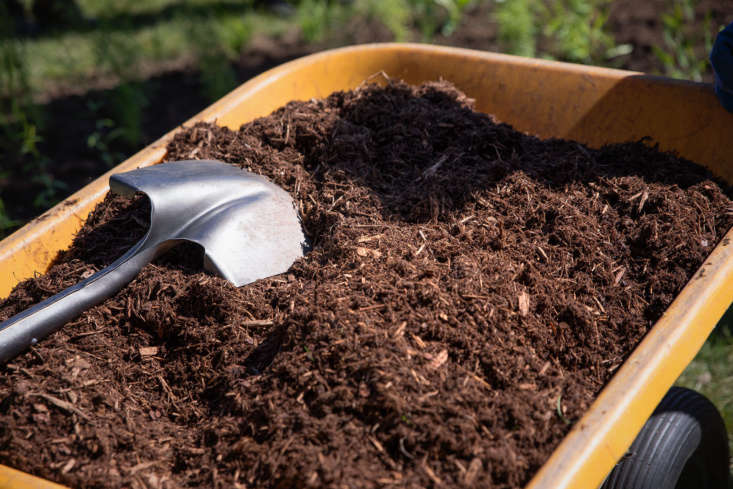It’s spring, time to finally start working in the garden! The first task on many gardeners’ to-do list: order soil amendments and mulch. But it’s important to understand what your garden needs before placing that order or going to the local nursery. Knowing what to use and when to use it can help you grow healthy plants, tamp down weeds, and save water.
Read on to learn more.
When to use compost?

Compost is used to restore nutrients and improve soil structure. It is the ultimate recycling. It returns organic matter back to the soil. There are several different kinds of compost. The most common is homemade. This is your well-rotted kitchen scraps, coffee grinds, and grass clippings that have been decaying for months in your compost pile. It’s what’s known as black gold and it’s that valuable to plants.
The next most common type is cow manure, but it can be horse or chicken poop, too. The single most important thing to remember about farmyard poop is that it can’t be used “fresh.” It needs to “rot” a bit, so that the ammonia and nitrogen have had time to dissipate (and the smell, too!) and not burn your plants. Other lesser known composts are green manure where a cover crop of legumes (the clover family is common) is sowed, grown, and then tilled into the soil, and vermicompost where worms do the heavy lifting of breaking down organic matter instead of bacteria.
You can add compost to your garden beds ahead of planting. You can top-dress the soil or you can till it in. But realize that tilling can destroy soil structure. Best to use a garden fork to gently aerate the soil and then top dress.
If you’re a minimalist gardener, compost is the single-most important thing you can add to your soil—and when it’s used as top dressing, it can even double-duty as mulch and suppress weeds.
When to use fertilizer?

When should you use fertilizer? After you get the results back from the soil test you had done at your cooperative extension office. Seriously. How do you know what your soil is lacking without testing? Perhaps your plants don’t need any fertilizer at all. Once you know what your soil needs, you can add the correct fertilizer.
Generally, fertilizer is added prior or at the beginning of the growing season. This goes for all plants—your trees, shrubs, vegetables, and flowers. Some plants, like tomatoes, are heavy feeders and may need extra applications of fertilizer applied during the growing season. Please read and follow the directions exactly. More is not better. More can burn or kill your plants or lawn. More can lead to unhealthy growth. Applying fertilizer at the wrong time can stress your plants. Applying it too close to dormancy can encourage growth too late in the season that will be killed during winter. Applying too much or at the wrong concentration can burn your lawn.
All fertilizer will have three numbers on the package representing NPK ratios (N is for nitrogen, P for phosphorus, and K for Potassium.) Applying nitrogen-rich fertilizer to vegetables such as tomatoes will produce all leaves and no fruit. Nitrogen is good for lawns, which is all leaves. Phosphorus is what helps make flowers, fruits, and strong roots. Potassium is great to help plants use the other two. Stay away from balanced fertilizers, those with the same number in all three slots. You are better off using specific fertilizers for specific uses rather than a general one, which could cause more problems than it solves.
And if you find yourself choosing between synthetic and organic fertilizers (natural substances like kelp, limestone, and blood meal), choose the latter. Aside from being more eco-friendly, organic fertilizers are gentler and slower-acting (less risk of burning your plants) and they improve soil structure to boot (something that synthetic versions can’t do).
When to use mulch?

Mulch is used to keep weeds down, retain moisture, and moderate soil temperature. Additionally, it adds organic material to the soil, which improves soil structure. It’s also used for aesthetic reasons. “Organic” mulch means it’s made from plants, such as bark chips, shredded hardwoods, pine needles, and leaves (it doesn’t mean it’s pesticide-free, although that is a good idea). Inorganic materials are black or red plastic (to be avoided), and newspapers and cardboard (which can be used to suppress and kill weeds, à la lasagna gardening).
Mulch should be added in mid-spring after the soil starts to warm. Applying mulch too soon will insulate the soil at a cooler temperature and it will take longer to warm up. Plants will take longer to come out of dormancy. Soil temperatures should be in the 50Fs before applying mulch. Plant-based mulch should be applied to a depth of two to three inches and kept four to six inches away from the base of trees and shrubs to avoid trapping moisture against the base of the plant.
Mulches to avoid: cocoa-based mulches, which can be deadly to dogs if eaten; dyed mulches and rubber mulches, both of which can leach harmful chemicals, contaminating the plant, soil, and waterways.
Knowing when to apply and how to correctly use mulch, compost, and fertilizer will produce healthy and happy plants, make less work for you, and give you more time to enjoy your garden.
For more on soil health, see:
- Kitchen to Garden: 6 Common Household Ingredients to Use for Healthier Soil and Plants
- Just Say No to Peat: It’s Time to Rethink the Compost and Soil You Buy
- The Garden Decoder: Should You Get a Soil Test?









Have a Question or Comment About This Post?
Join the conversation